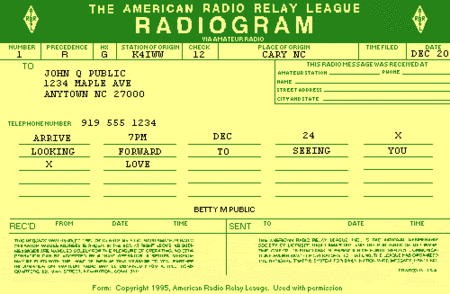As the National Traffic System (NTS) ages, attempts to evolve the service by some of its maverick adherents have caused quite a stir between the ARRL and NTS management. Add FEMA to the mix and we have a…
Lawsuit?
What do FEMA, the ARRL and the National Traffic System (NTS) have in common? Legal wrangling apparently.
You can’t make this stuff up so please have a read of these two posts to boot yourself on the alleged problems…
The QNI Newsletter offers the opportunity for all to examine the evidence outlining the email traffic between a FEMA rep and NTS management in their August 4th issue.
The Zed has the usual rich tapestry of thoughts on this topic, but the above articles summarize the two opposing viewpoints reasonably well. It boils down to two philosophies: Central planning and maverick individualism. Here are some VAPN comments to both.
UPDATE Fall 2017: US Court of Appeals Upholds Dismissal of Lawsuit in Ames v ARRL Case
ARRL central planning
One of the pragmatic features of the NTS radiogram is the relative simplicity of the format. Yeah it takes some time to acquaint oneself with the particulars, but you get the hang of it after filling out a few forms. Once filled out, the radiogram contains all the necessary components to dump into the nearest traffic net and get it moving towards its destination… albeit slowly. The key to NTS’s success is the routing information built into the radiogram and the fact anyone can “pass” the information. There is an inherent beauty and efficiency in the no nonsense format. To make this work well, some form of central planning makes sense and the American Radio Relay League is the logical organization to perform this task for the CONUS. This “central planning” was done many decades ago in the initial design of the NTS so it is not clear what other “planning” must be done.
Maverick individualism
The goals of the VAPN are more regional in nature. NTS messages from and to local zip codes will certainly work quite well, but so will full fledged “P” messages be they simple text or ICS form data. When the built-in routing ability of packet based NTS is unnecessary, “P” messages make more sense. That said, we cannot forget the NTS format is readymade to pass messages between non-hams. The point is regional users of the VAPN can dictate their own procedures to suit their individual needs.
NTS Agnosticism
The VAPN will certainly support the NTS message type since it is built deep into the packet system paradigm. In addition the regional nature of the VAPN suggests locals can use NTS messages however and whenever they choose for any traffic that stays in the region.
Group Agnosticism
With the rare exception of ultra dire situations, the VAPN will be beholden to no particular group or organization. There is simply no way for anyone to know if individuals’ messages are any less important than those from an organized emergency communications group. Fortunately, given sufficient bandwidth, packet radio allows the two to mix.
Let us not forget the key point of amateur radio is facilitating peer to peer communications… a key feature of a free society.
Viva la liberte.
Conclusion
Credit goes to the ARRL for outlining the NTS with its clever and succinct message and routing protocol… in the 1940s. Other than some cheerleading, education and maintenance of very high level organizational details, what actually requires management anymore? Furthermore the people will use it if they want it, and won’t if they don’t.
